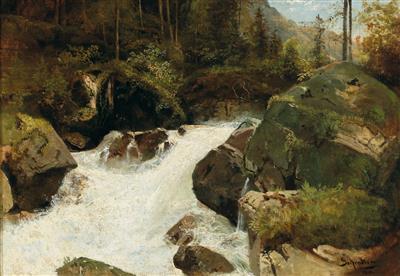Emil Jakob Schindler

(Vienna 1842–1892 Westerland on Sylt)
Scene from the Gesäuse region, signed, dated Schindler 1862,
oil on canvas, 47 x 67 cm, framed, (W)
Catalogued and illustrated in:
Heinrich Fuchs, Emil Jakob Schindler, Zeugnisse eines ungewöhnlichen Künstlerlebens, Werkkatalog, Dr. Heinrich Fuchs Selbstverlag, Vienna, CR no. 3, p. 141
Provenance:
Collection of Eduard Kremser (1838-1914), Vienna;
Sale C. J. Wawra, Vienna, 2 May 1917, lot 130;
Sale Ignaz Schwarz, Vienna, 24 November 1918, lot 708;
Private Collection, Germany.
Landscape painter Emil Jakob Schindler is one of the most significant representatives of Austrian Impressionism. He was active in the second half of the nineteenth century. His early works, in particular, are visibly influenced by his tutor, Albert August Zimmerman, who taught him at the Viennese Academy. Subsequently, Schindler attempted to leave behind the composition favoured by the older generation and drive forward a new kind of image composition. Schindler moved elements that originally dominated the construction of the image to the edge of the image, and interrupted the user’s habitual way of looking at images. The Barbizon School represents another significant influence on Schindler’s work; Schindler came into contact with the School through trips with his tutor Zimmermann and other students. These summer study trips often lasted several weeks and took attendees to Salzburg, as well as other locations. During the trips, the young students were able to exchange ideas with artists from the Viennese and Munich scenes and get to grips with new artistic movements. However, it was not only French artists such as Gustave Courbet or Jean Baptiste Camille Corot who piqued Schindler’s interest: Dusseldorf-based brothers Oswald and Andreas Achenbach also had a substantial impact on him.
Schindler’s landscapes are far removed from heroic struggles; rather, they represent “everyday” landscapes, with the artist taking a critical stance on man-made changes to the landscape. In this regard, his works on the regulation of the Danube are noteworthy. This topic was also painted by several contemporary artists, such as Tina Blau. His palette ranges from various shades of brown to muted green and grey tones. There are also similarities with the Barbizon School in this regard. The use of light in his landscapes creates a calm, atmospheric effect. His works always have a contemplative feel – he largely avoids drama. The protagonists never seem to be in danger, even when his works depict forces of nature. He completed studies on site, and did not bring these together and develop them into a painting until he was in the studio. In his landscapes, Schindler did not just attempt to depict what he saw, but also tried to represent an intrinsic sensation.
Expert: Dr. Christl Wolf
 Dr. Christl Wolf
Dr. Christl Wolf
+43-1-515 60-377
19c.paintings@dorotheum.at
19.10.2017 - 18:00
- Odhadní cena:
-
EUR 15.000,- do EUR 25.000,-
Emil Jakob Schindler
(Vienna 1842–1892 Westerland on Sylt)
Scene from the Gesäuse region, signed, dated Schindler 1862,
oil on canvas, 47 x 67 cm, framed, (W)
Catalogued and illustrated in:
Heinrich Fuchs, Emil Jakob Schindler, Zeugnisse eines ungewöhnlichen Künstlerlebens, Werkkatalog, Dr. Heinrich Fuchs Selbstverlag, Vienna, CR no. 3, p. 141
Provenance:
Collection of Eduard Kremser (1838-1914), Vienna;
Sale C. J. Wawra, Vienna, 2 May 1917, lot 130;
Sale Ignaz Schwarz, Vienna, 24 November 1918, lot 708;
Private Collection, Germany.
Landscape painter Emil Jakob Schindler is one of the most significant representatives of Austrian Impressionism. He was active in the second half of the nineteenth century. His early works, in particular, are visibly influenced by his tutor, Albert August Zimmerman, who taught him at the Viennese Academy. Subsequently, Schindler attempted to leave behind the composition favoured by the older generation and drive forward a new kind of image composition. Schindler moved elements that originally dominated the construction of the image to the edge of the image, and interrupted the user’s habitual way of looking at images. The Barbizon School represents another significant influence on Schindler’s work; Schindler came into contact with the School through trips with his tutor Zimmermann and other students. These summer study trips often lasted several weeks and took attendees to Salzburg, as well as other locations. During the trips, the young students were able to exchange ideas with artists from the Viennese and Munich scenes and get to grips with new artistic movements. However, it was not only French artists such as Gustave Courbet or Jean Baptiste Camille Corot who piqued Schindler’s interest: Dusseldorf-based brothers Oswald and Andreas Achenbach also had a substantial impact on him.
Schindler’s landscapes are far removed from heroic struggles; rather, they represent “everyday” landscapes, with the artist taking a critical stance on man-made changes to the landscape. In this regard, his works on the regulation of the Danube are noteworthy. This topic was also painted by several contemporary artists, such as Tina Blau. His palette ranges from various shades of brown to muted green and grey tones. There are also similarities with the Barbizon School in this regard. The use of light in his landscapes creates a calm, atmospheric effect. His works always have a contemplative feel – he largely avoids drama. The protagonists never seem to be in danger, even when his works depict forces of nature. He completed studies on site, and did not bring these together and develop them into a painting until he was in the studio. In his landscapes, Schindler did not just attempt to depict what he saw, but also tried to represent an intrinsic sensation.
Expert: Dr. Christl Wolf
 Dr. Christl Wolf
Dr. Christl Wolf
+43-1-515 60-377
19c.paintings@dorotheum.at
|
Horká linka kupujících
Po-Pá: 10.00 - 17.00
kundendienst@dorotheum.at +43 1 515 60 200 |
| Aukce: | Obrazy 19. století |
| Typ aukce: | Salónní aukce |
| Datum: | 19.10.2017 - 18:00 |
| Místo konání aukce: | Wien | Palais Dorotheum |
| Prohlídka: | 07.10. - 19.10.2017 |
Další objekty umělce
-

Odhadní cena:
EUR 6.000,- do EUR 10.000,-
Všechny objekty umělce
